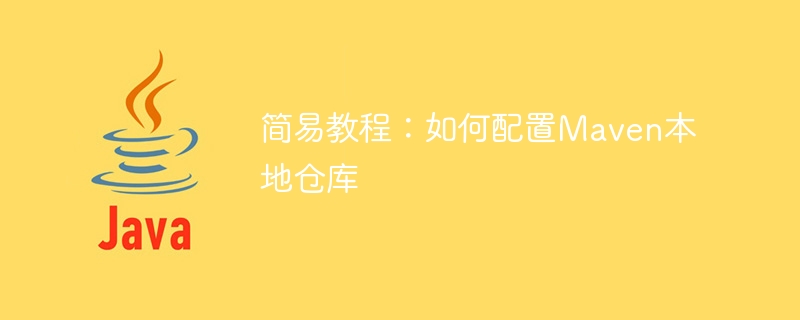Home >Java >javaTutorial >Maven local warehouse configuration: an easy-to-understand tutorial
Maven local warehouse configuration: an easy-to-understand tutorial
- PHPzOriginal
- 2024-01-05 15:52:321283browse

Simple tutorial: How to configure Maven local repository
Introduction: Maven is a popular build tool that uses a central repository to manage and download dependencies. However, in some cases, it may be inconvenient to access the central repository. In this case, we can configure the Maven local repository to manage the dependencies we need. This article will introduce how to configure the Maven local warehouse and provide specific code examples.
Step 1: Download and install Maven
First, you need to download the latest version of Maven from the Maven official website (https://maven.apache.org/download.cgi) and follow the instructions on the official website The guide to install it locally.
Step 2: Configure Maven environment variables
Add the bin folder path in the Maven installation directory to the system environment variables. This way, we can use Maven commands anywhere.
Step 3: Create Maven project
In the command line, enter the folder where you want to create the Maven project, and execute the following command:
mvn archetype:generate -DgroupId=com.example -DartifactId=my-app -DarchetypeArtifactId=maven-archetype-quickstart -DinteractiveMode=false
After successful execution, Maven will Automatically create a basic Maven project structure.
Step 4: Configure the local warehouse
In the root directory of the Maven project, find and open the pom.xml file. In the
<repositories>
<repository>
<id>local-repo</id>
<url>file://${user.home}/.m2/repository</url>
</repository>
</repositories>This code will configure Maven to use the local warehouse to resolve and download dependencies.
Step 5: Compile and run the project
In the command line, enter the root directory of the Maven project and execute the following command to compile the project:
mvn compile
After the compilation is successful, execute the following command Run the project:
mvn exec:java -Dexec.mainClass="com.example.App"
This command will execute the main method of the App class.
Step 6: Add dependencies
If you need to add additional dependencies to your project, you can add relevant dependencies in the
<dependency> <groupId>org.springframework</groupId> <artifactId>spring-core</artifactId> <version>5.3.8</version> </dependency>
This code will introduce the core library of the Spring framework into the Maven project.
Conclusion:
By configuring the Maven local warehouse, we can manage and download dependencies without access to the central warehouse. This article describes how to download and install Maven, how to configure Maven environment variables, and how to create a Maven project and configure a local warehouse. At the same time, code examples are also provided to demonstrate how to add dependencies to Maven projects. Hope this tutorial helps you!
The above is the detailed content of Maven local warehouse configuration: an easy-to-understand tutorial. For more information, please follow other related articles on the PHP Chinese website!

